Why Some Men Don’t Use Condoms: Male Attitudes about Condoms and Other Contraceptives
- Report: Why Some Men Don’t Use Condoms: Male Attitudes About Condoms and Other Contraceptives
The independent source for health policy research, polling, and news.
Small Employers and Health Insurance
Nearly half of all uninsured workers are either self-employed or work for firms with fewer than 25 employees; another 14% are in firms with 25-99 workers (EBRI, 1996). Differences in health coverage depending on the size and type of businesses have existed for years. Today, only half of small businesses sponsor health benefits.
Health insurance among small employers has changed dramatically during the first half of the 1990s, however. More are offering coverage and there has also been a major shift in the nature of health coverage. Now two-thirds of small firms offering insurance provide coverage through a managed care plan. This contrasts sharply with a few years ago when small employer offerings of health maintenance organizations (HMOs), preferred provider organizations (PPOs), and point-of-service plans (POSs) were relatively rare.
Who Offers Coverage?
Fifty-three percent of businesses with less than 50 employees offered health insurance in 1995. Firms with more employees, those that are incorporated, and firms that are older are much more likely to sponsor insurance.
Within nearly all sizes of small firms, health coverage declined between 1989 and 1991, due largely to the economic recession. The improving economy and to a small extent, state reforms in the small group market, are responsible for the increase in coverage since then (Figure 1).
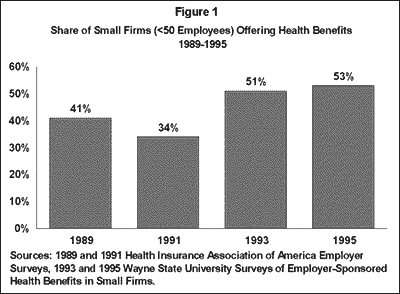
The Changing Nature of Coverage Provided
Between 1993 and 1995 many small businesses began offering managed care plans for the first time. By 1995 managed care became the dominant form of health coverage in the small group market, covering 70% of all workers insured through small firms, from only 27% just two years earlier (Figure 2).
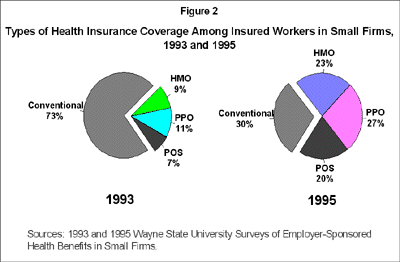
Small firms have shifted to managed care plans for a combination of reasons: the limited nature of their previous conventional coverage, the rising price of such plans relative to managed care premiums, and the expansion of managed care plans into the small group market.
It is still the case however, that most small businesses that offer insurance offer only one plan. Today that plan is much more likely to be a managed care plan rather than conventional insurance (i.e., indemnity or fee-for-service). Only 10% of insured workers in small firms are offered a choice of plans, whereas in firms with 200 or more workers, 84% can choose from a menu of plans.
Why More Small Firms Don’t Sponsor Insurance
Small firms choose not to provide health benefits for many different reasons. Most small businesses (83%) say it is because premiums are too high (Figure 3). Additional reasons include: the firm’s profits are too uncertain to commit to it, health insurance is not a high priority among its workers, or the administrative burden would be too great. The problem is not a lack of opportunity to buy coverage. Most uninsured firms report they are inundated with solicitations to purchase a plan.
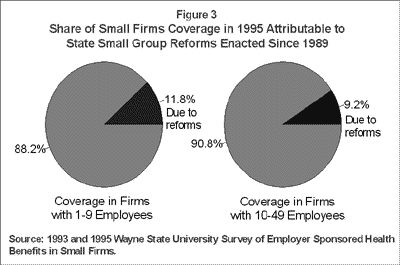
Studies of insurance demand suggest that small firms are extremely price sensitive, e.g., a 5% decrease in price would result in a 10-15% increase in the likelihood of purchasing a plan. On the other hand, recent evaluations of several state subsidy programs for small businesses have found that these programs did not spur much new coverage.
The findings from these demonstration projects however, may have resulted from a lack of knowledge about the programs, the short-term nature of the subsidies, and in some instances, the fact that no premium subsidy was provided for insuring the business-owner and his or her family, rather, only employees’ premiums were eligible for a subsidy.
Policies Available in the Small Group Market
Access:
Health insurance has become more accessible to small firms in recent years. Fewer firms in 1995 said that an inability to qualify for group coverage was a major barrier to their offering a plan (46% vs. 54% in 1993). Fewer also reported that particular workers or their dependents were being excluded from the company plan due to poor health. One reason for these changes is that many states enacted “guaranteed issue” legislation in the early 1990s. Another reason is that more HMOs have expanded into the small group market and since most HMOs are federally qualified, they must guarantee the issue and renewal of their policies to all within the market.
Cost-sharing:
Overall, the gap between the cost-sharing provisions in small and large firms plans is narrower than it was just a few years ago. Average deductibles for conventional insurance have actually fallen for small businesses. This is partly a result of the shift to managed care because many of the conventional plans that small firms dropped had higher-than-average deductibles. While small firms’ deductibles are still higher than those in large firms, the gap has narrowed since 1993. At the same time, copayments in HMOs offered by small firms have increased significantly. Copayments of $10 to $20 per visit are now the norm, instead of $3 to $9 per visit, as in 1993. Small firms’ copays are still higher than those of large firms, but the differences are not that large.
Premium-sharing:
Small businesses have also made changes in their premium-sharing arrangements since 1993. Significantly fewer workers are being asked to contribute toward premiums, however the average percent contribution among those required to contribute has risen (Figure 4.)
Figure 4Premium-Sharing in Small Firms (<50 Employees), 1993 and 1995 Single Coverage: 1993 1995 Percent of workers required to contribute to single coverage premium 49% 30% Avg. contribution as a percent of single premium (among those required to contribute) 39% 44% Family Coverage: 1993 1995 Percent of workers required to contribute towards family coverage premium 59% 46% Avg. contribution as a percent of family premium (among those required to contribute) 47% 54% Source: 1993 and 1995 Wayne State University Survey of Employer Sponsored Health Benefits in Small Firms Issues
Funding for the sources of information on this fact sheet and the 1995 Survey of Small Businesses was provided by the Henry J. Kaiser Family Foundation:
Small Employers: Health Insurance Coverage and the Impact of State Reforms:Fact Sheet Fact Sheet 2
Fact sheets on health insurance among small employers and state reforms of small group health insurance.
Retiree Health Trends and Implications of Possible Medicare Reforms
Prepared by: Hewitt Associates LLC
Prepared for: Kaiser Medicare Policy Project
September 1997
Preparation of this report was supported by The Henry J. Kaiser Family Foundation Grant Number 96-1710B. The study consists of a review and analysis of recent trends in the provision of employer-sponsored health benefits to retirees, as well as an assessment of potential changes to employer-sponsored retiree health plans in the future, including the effects of certain proposed changes to Medicare. The views expressed in this paper are solely the responsibility of the authors and do not necessarily represent those of The Henry J. Kaiser Family Foundation.
Acknowledgments
This report was prepared by Frank B. McArdle, Ph.D., and Dale H. Yamamoto, F.S.A., of Hewitt Associates, a global management consulting firm specializing in human resource solutions. Saline Leckman prepared the tables allowing for a comparison of trends between 1991 and 1996. Libby Terry and Nancy Newman collaborated on many aspects of this report.
For Further Information Contact:
Contents
Retiree Health Benefits Play an Important Role
Employer-sponsored retiree health benefits are a source of valuable coverage to individuals, both through the provision of coverage to early retirees before they become eligible for Medicare and as a supplement to Medicare for retirees age 65 and over. More than a third (approximately 12 million) of Medicare aged and disabled beneficiaries have employer-sponsored coverage.
In 1996, most large employers (1,000 or more employees) provided some form of retiree health benefits, of which the vast majority provided coverage both before and after age 65. However, because of rising health care costs and changes in accounting rules, and after years of expanding coverage and benefits, the prevalence of employers offering such coverage has been declining since the early 1990s; eligibility has been tightened; and more of the costs have been shared with retirees.
In addition, because Medicare pays a large portion of the costs for post-65 retirees, certain proposed changes to Medicare could potentially accelerate the decline in retiree health coverage by shifting financial liability to employers and to retirees.
The purpose of this study is twofold:
Key Trends
Part I of this report analyzes key trends in retiree health plans for a constant sample1 of large companies in the Hewitt database, finding that between 1991 and 1996, the vast majority of large employers continued to provide retiree health benefits, but there were significant changes in coverage, eligibility rules, and beneficiary contribution requirements. (Figure 1 summarizes selected key findings with respect to coverage of retirees.)
Availability of coverage declined for retirees ages 65 and over
More retirees charged premiums
Eligibility for postretirement medical coverage tightened through higher age and service requirements
Financial caps placed on future retiree health obligations
More employers encourage use of managed care for retirees
Implications of Medicare Reforms
Changing our focus from existing trends to possible future changes in retiree health plans, Part II of this report considers another potential wave of changes that might result from three significant Medicare reform proposals.
Option #1: Proposed increase in the Medicare age of eligibility
During the recent Medicare reform debate in connection with the Balanced Budget Act of 1997, the Senate included a provision that would have gradually raised the Medicare age of eligibility from 65 to 67, in tandem with the already scheduled increase in the Social Security eligibility age. Although dropped from the final bill, this issue will likely be revisited, and if enacted, could have a significant impact on retiree health plans. A few examples of the impact of raising the eligibility age include:
Option #2: Changes in Medicare payments to Medicare HMOs
With employers increasingly moving toward Medicare managed care to keep costs down and provide comprehensive coverage to retirees, the favorable financial impact of that strategy could be significantly affected by changes in the way Medicare pays health plans in the future.
The Balanced Budget Act of 1997 makes significant changes in payments to Medicare managed care plans, in part to increase payment rates in rural areas but also to reduce future Medicare spending increases. Employers will soon begin the process of assessing what the specific financial impact of these changes may be. The revised payment formulas may significantly alter the geography of Medicare managed care plan offerings to retirees, as well.
Smaller payment increases in certain areas of the country as a result of the 1997 legislation could potentially make managed care plans less attractive to employers and to retirees in those areas if HMO benefits are reduced or premiums rise. Alternatively, payment and other policies that support the expansion of Medicare managed care may help to stabilize retiree health benefit coverage by helping to manage employer costs over the long term.
Option #3: Proposed shift to a defined contribution program
Another option for reforming Medicare, supported by some experts in the health care community, is to shift away from having Medicare pay the cost of each beneficiary’s care, e.g., a defined benefit approach, toward a defined contribution approach in which Medicare would pay a fixed sum for each beneficiary, who would then use that sum, e.g., through a voucher-like mechanism, to select coverage from competing health plans. In fact, the Balanced Budget Act of 1997 creates a private fee-for-service option under Medicare+Choice. The conferees note that this private fee-for-service option “represents the first defined contribution plan in which beneficiaries may enroll in the history of the [Medicare] program.”4
Broad-based use of a defined contribution approach, while empowering retirees to choose their own health plan, also shifts financial risk to employers sponsoring retiree health plans and to retirees. In addition, that cost shift could grow over time if the defined contribution rate increases yet fails to keep pace with medical inflation. This is particularly worrisome to employers because Medicare coverage is already less generous than what large employers typically offer active employees. Comparing the plan value of Medicare benefits to those of 250 large employers participating in the 1996 Hewitt Health Value InitiativeTM database, 82 percent of the indemnity plans offered to active employees provide higher benefit levels than Medicare.
A broad-based defined contribution scheme for Medicare could also create administrative complexities for employers, in terms of the difficulty of coordinating the retiree plan with the specific Medicare health plans retirees choose, and determining an appropriate price for them.
The combination of financial and administrative impacts could thus lead employers to reassess the manner and the extent of coverage they offer to future retirees.
Summary
Retiree health benefits remain important to employees and retirees, even though the prevalence of such coverage has declined, eligibility has tightened, and more cost sharing is required of retirees. Potentially the biggest source of profound changes to employer-sponsored retiree health programs in the future would come from proposals to restructure the Medicare program. Depending on their specific nature, such changes could either create a safety net beneath employer-sponsored coverage for retirees or create additional incentives for employers to cut back. Policymakers focusing on potential reforms of Medicare would be well advised to take a more integrated look at the interactions between Medicare coverage and the employer-sponsored retiree health coverage on which millions of retirees still depend.
About the Hewitt Associates Database
Hewitt Associates has been tracking the salaried employee benefit provisions of major employers since 1972 through annual updates to its database of companies. The 1996 Hewitt database contains plan design information on 1,050 major employers, including 62 percent of Fortune 500 companies. Analyses of trends based on large employers (e.g., those with usually at least 1,000 employees) provides a reliable indication of the main sponsors of employer-provided coverage for retirees, because smaller firms are far less likely to provide such coverage. Ninety percent of the Hewitt database consists of companies employing 1,000 or more employees; 57 percent of the database consists of companies with 5,000 or more employees, representing roughly 25 percent of all public and private companies in the United States of that size.
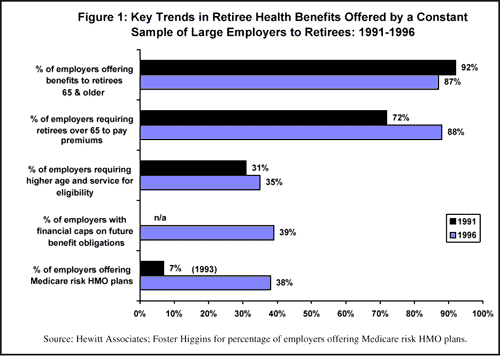
Retiree Health Trends And Implications Of Possible Medicare Reforms:Press Release Fact SheetReport Part One Part Two Part Three Part Four Part Five Part Six Part Seven Part Eight
Retiree Health Trends And Implications Of Possible Medicare Reforms
September 1997
Approximately 12 million of Medicare’s 39 million beneficiaries receive employer-sponsored retiree health benefits as a supplement to their Medicare coverage. In addition, millions of retired workers under age 65 rely on retiree health benefits as their primary source of health insurance coverage. While employer-sponsored health insurance is an important source of coverage for current retirees, health benefits for future retirees are uncertain.
Retiree Health Benefits Decline, 1991-1996
A declining share of large employers offered health benefits to retirees in 1996 compared to 1991, and an increasing share implemented reforms to limit their financial liability for retiree coverage (Figure 1), based on an analysis of a constant sample of about 600 large employers (with 1,000+ employees) conducted by Hewitt Associates LLC.
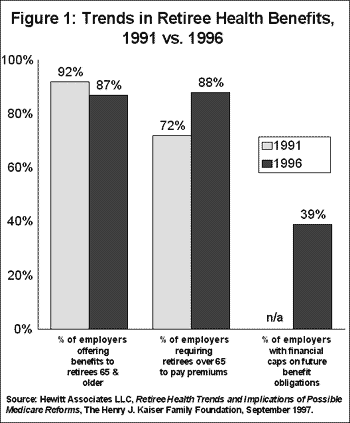
Availability of retiree coverage has declined:
Based on a constant sample of large employers, the share of employers offering retiree benefits to retirees age 65 and over declined from 92 percent in 1991 to 87 percent in 1996. Coverage for pre-65 retirees remained relatively stable. By comparison, the proportion of all large firms offering retiree coverage declined from 80% in 1991 to 71% in 1996, based on the Hewitt database.
Required payment of premiums has increased:
The share of large employers requiring post-65 retirees to pay premiums increased from 72 percent in 1991 to 88 percent in 1996; for pre-65 retirees, the share increased from 85 percent to 95 percent.
Use of financial caps has grown:
Dollar caps on future employer obligations for retiree health costs has emerged as a new feature of retiree benefits. In 1991, virtually no large employers had such caps; by 1996, 39 percent had caps on post-65 retiree coverage and 36 percent had caps on pre-65 coverage.
Other reforms have been implemented:
Between 1991 and 1996, a growing share of large employers tightened eligibility requirements, increased deductibles, raised contributions for dependent coverage, and increased enrollment of retirees in managed care plans.
The trend toward declining retiree benefits in the 1990s is due to a number of factors including: the pressure to control increasing health care costs; new accounting rules (FAS 106) which require companies to report accrued future retiree health benefit liabilities on their current financial statements; and employer concerns about the future financial impact of an aging population.
Medicare Reforms Affect Employer-Sponsored Retiree Coverage
Because retiree health benefits generally supplement Medicare for retirees age 65 and older, changes in the Medicare program are likely to affect health care costs incurred by both employers and retirees. For example, raising Medicare’s eligibility age gradually from 65 to 67 (linking the Medicare and Social Security eligibility age) would increase the actuarial costs for lifetime retiree benefits by 12 percent for large employers with a younger workforce and by 8 percent for employers with an older workforce (Figure 2). When fully implemented at age 67 (no phase-in), this change would increase costs by 16 percent for employers with a younger workforce and by 18 percent for employers with an older workforce. This is because the average per person cost of health coverage for a retiree before Medicare eligibility is about three times the cost of a retiree with Medicare coverage ($4,000 vs. $1,350, respectively) (Figure 3).
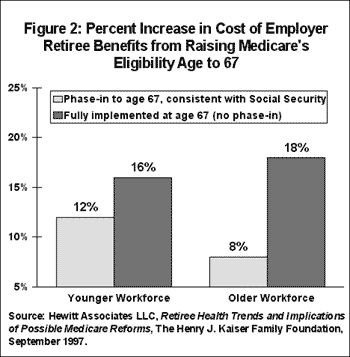
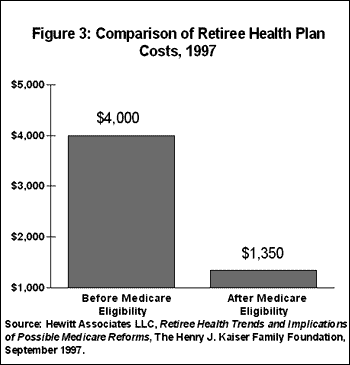
Changes in Medicare HMO payments could also impact retiree health costs. Higher Medicare HMO payments in rural areas, as enacted under the Balanced Budget Act of 1997, could encourage the migration of plans to rural areas and allow employers in these areas to move additional retirees into managed care plans. However, reductions in future Medicare payments to HMOs in other areas could make managed care a less attractive option for employers and retirees if HMOs respond to payment changes by offering fewer benefits or charging higher premiums.
More comprehensive Medicare reforms under discussion, such as a shift to a defined contribution program, could also impact employer-sponsored retiree coverage. Under a defined contribution approach, Medicare would pay a fixed sum on behalf of each beneficiary and beneficiaries could apply the amount to the cost of coverage from a variety of Medicare-approved private health plans. If Medicare’s defined contribution rate does not keep pace with medical inflation, additional costs are likely to be shifted to employers, retiree with employer-sponsored coverage, and other beneficiaries.
Issues
Employer-sponsored retiree health plans play an important role in covering retirees both before and after Medicare eligibility. Retirees are generally at an age when health problems tend to increase, annual incomes decline, and coverage for medical expenses becomes more critical. Since 1991, there have been declines in the availability and generosity of retiree health benefits offered by employers. Employers and retirees face significant financial risks from potential changes to the Medicare program because of the strong interaction between employer-sponsored retiree health benefits and the Medicare program.
This fact sheet is based on Retiree Health Trends and Implications of Possible Medicare Reforms, prepared by Hewitt Associates LLC with support from the Kaiser Family Foundation, September 1997. This study analyzed key trends in retiree health plans from 1991 through 1996 using a constant sample of large companies (generally those with at least 1,000 employees) in the Hewitt Associates database. The 1996 Hewitt database contains plan design information for 1,050 major employers. The study also analyzed the potential impact of Medicare reform options on retiree health plans.
Retiree Health Trends And Implications Of Possible Medicare Reforms:Press Release Fact Sheet Report
With the assistance of the First Nations Development Institute, the Henry J. Kaiser Family Foundation commissioned several studies of critical issues in Native-American health care. These studies examined the trends shaping the future of Native-American health care; the existing health systems and planning capacity in the Native-American health care system; the changes occurring in the IHS; the role of Medicaid in Native-American health care; the attitudes and preferences of Native American health care consumers; and the factors shaping the decisions being made by tribal leaders. The findings from these studies were presented at a Kaiser Forum on the “Implications of Changes in the Health Care Environment for Native-American Health Care,” in Washington, D.C., November 1996. The studies and a synthesis of the Forum discussion are published in this report.
“DSH” Provisions…the Balanced Budget Act of 1997, P.L. 105-33
This report was prepared by the Center on Budget and Policy Priorities for the Kaiser Commission on the Future of Mediciad.